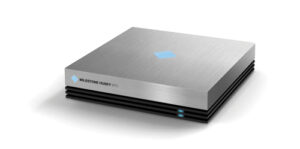 The Husky M10 reviewed is an 8 channel dedicated NVR housed in a small square-footprint box measuring 200 x 200 x 46 mm in height excluding the connectors and has a weight of approximately 2.5 kg.
The Husky M10 reviewed is an 8 channel dedicated NVR housed in a small square-footprint box measuring 200 x 200 x 46 mm in height excluding the connectors and has a weight of approximately 2.5 kg.
A monitor, keyboard and mouse can be connected for initial configuration following which it can be interrogated over the network.
Two blue LED lights on the front panel show Power is connected (upper) and system activity (lower).
When connected the boot-up sequence takes around 1 minute to complete and then an embedded Firefox browser screen is presented which gives a log-in option along with links to Milestone online tutorials via YouTube and Milestone App download information from the Milestone website if the network is internet enabled.
The login gives a warning against operating the unit with a monitor connected as this will cause a loss of performance. An End User License Agreement must then be accepted before the first login.
After accepting the licence agreement a simple Home View screen gives selectable options in the top right corner of the screen for EXPORTS, SETTINGS, LEARN and LOG OUT plus a search bar option to “Search all cameras”.
Hardware
The unit is based on a Nexcom small format fan-less PC with American Megatrends BIOS installed as can be seen briefly from its initial splash screen when powering up. It runs a Linux operating system that auto-runs a Firefox browser based user interface.
The rear panel has from left to right a power switch, a DVI socket, an HDMI socket, four USB ports, two LAN RJ45 sockets and a 12v DC IN locking power connector.
USB ports can be used to connect a standard PC keyboard and mouse for any configuration changes necessary. The case when running was measured at a temperature of approximately 37°C with an ambient of 26°C.
The momentary power switch when activated during operation gives a Log Out, Restart or Shut Down option window. If the Log Out option is selected, it was found that you are presented with a password protected log-in screen with nothing noted in the quick-start guide to deal with this however a top right pull down menu power option allows you to Suspend, Hibernate (greyed out), Restart or Shut down. Shut down is also given an Alt + F4 shortcut.
Operation
To operate the Husky M10 directly via a browser it is important to follow the quick-start guide carefully and have the correct plug-ins in place. Firefox is recommended as it appears that Microsoft’s Internet Explorer and Google’s Chrome may not support all preferred functions.
The replay options are quite limited but useable with a slider method used to show replay date and time behind a blue indicator line. The timeline can be dragged behind this indicator to change the time of interest. If you move back beyond the earliest recording then a “Before database start” message alerts you to the earliest recording time.
A slider bar is used to increase the playback speed but there is no indication of the play rate.
For more flexible performance the Husky can be controlled using the Milestone XProtect range of software packages or for mobile applications a free XProtect Mobile Server component can be downloaded and installed from the Milestone website. Once installed free Android, iOS and Windows Mobile apps are available that provide a straightforward means to connect to the device and monitor all of the connected cameras and to review footage from individually selected ones. A time & date scroll picker allows the correct time selection and then forward and reverse icons control the replay. A small window showing the real-time camera image continues to display in the top left corner of the screen while archive views are being replayed. This can be dragged to any other part of the screen or removed to allow all parts of the replay image to be viewable. PTZ functionality can be enabled for suitably configured cameras.
Good forward and backward play modes are available with a separate selection being made for replay speed. This can be selected from x0.1, x0.5, x1.0, x2.0 or x4.0 options.
Conclusion
The Husky M10 appears to be aimed at both the small system market and also for the larger installation where occasionally a limited input NVR is required perhaps for a remote site or secure location. With close attention to the instructions and appropriate IP principles very good results can be achieved.
Score: 9 out of 10
Note: The full review appears in the August edition of PSI magazine

